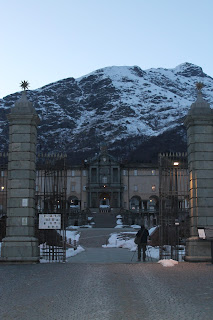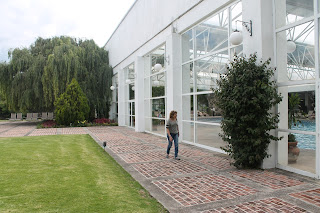Over the last 12 days, we have visited warm and sunny Michoacán, in Mexico, in this blog of the "Road of Faith and Art". This week we are in for a change in continental as well as in climate, yet it still remains the same road, the Road of Faith and Art.
Last Winter, we were in the Piedmont region of Northern Italy, in the city of Biella, and up in the hills, is the shrine of Oropa, where a statue of the Blessed Virgin Mary, or "la Madonna" as she is referred to here, carved in black ebony wood, was brought here by the first Christian bishop of this region, who brought it with him from the Holy Land, where it is believed that it aas commissioned by Saint Luke, the Evangelist, using the precious dark wood from neighboring Lebanon
Oropa is literally where the roads in
Piedmont end and the mountains begin.
The Shrine of Our Lady of Oropa is in the form of
a horseshoe.
Snow at the entrance gate at the
Oropa Sanctuary compound.
This stairway leads to the
Atrium of the Basilica
Superiore of Oropa
The surrounding mountains of
Oropa seem to be on the verge
of swallowing the Shrine.
The lower atrium of the Shrine of Oropa
A Sideview of the old Church of the
Shrine of Oropa
Clock and bell tower at the original
Church that houses the Madonna Nera.
Most of the day, the Madonna is
hidden behind this wooden door
Upon our request, the priest order
the door to be rolled over,
revealing the Madonna Nera
Here is the Madonna Nera de Oropa on the
Altar of the Old Church.
A closer look at the Madonna di Oropa
The rooms and passageways for pilgrims at Oropa
are lite up after dusk.
Main altar of the old church
Several frescoes painted in the old
Chruch of Oropa are in a state of ruin.
Baptismal fountain of the Old Church of Oropa.
New Basilica of Oropa
The hills surrounding Oropa on a late Winter afternoon.
The walkway from the parking garage towards
the Shrine of Oropa
My children having a snowball fight before entering
the new Neoclassical Basilica church of Oropa
Interior of the new Rotonda Basilica of Oropa
The New Basilica de Oropa has
a round shame within a square
somewhat similar to the Pantheon
of Rome.
On a clear day you might be able to see the valley
and city of Biella from this portico of the new
Basilica of the Shrine of Oropa
Near the Shrine is an Inn featuring typical
Piedmont dishes
The entrance of the nearby mountain inn at Oropa

























































